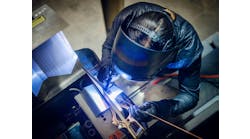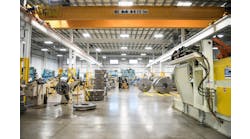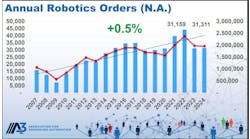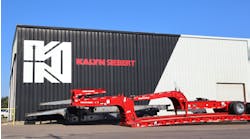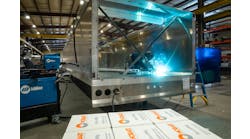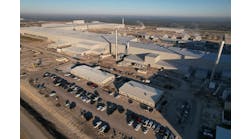Ready or not, disruptive technologies, like 3D printing and machine learning, are coming—and you can’t hide
Manufacturing is changing, and with each innovation, whether it’s in artificial intelligence, data analytics, 3D printing or robotics, the pace of change is accelerating. Those who don’t keep up stay behind.
That was the theme of FABTECH’s “Innovate, Accelerate and Advance Manufacturing” innovation panel hosted by Dave O’Neil, vice president of SME media, in November in Atlanta, Georgia.
The expert panel included Dan Kara, vice president of robotics at WTWH Media; Charlie Covert, vice president of customer solutions for UPS who’s also on the board of additive manufacturer Fast Radius; Jonah Myerberg, chief technology officer and co-founder of Desktop Metal, which specializes in 3D printing; and Michael Walton, Microsoft’s industry solutions executive director.
They shared their approaches to using innovation and advanced technologies to stay at the forefront of manufacturing, and the importance of embracing disruptive tech to stay competitive and profitable.
“Digital transformation is here,” Walton said. “It’s not going away, so don’t be afraid of it.”
Boarding now
People who aren’t down with the digital revolution often site confusion and cost as barriers to adoption. Nonsense, says Walton.
The reality, he said, is cloud-based analytics software is relatively inexpensive and easy to use—an army of IT geeks isn’t necessary—and, in fact, companies can’t afford not to invest in the technology.
“There’s a lot of revenue you’re leaving on the table, both in cost savings for yourself, as an organization, and for different new lines of service that differentiate you for your customers,” Walton said.
He also assured attendees the robots aren’t here for their jobs.
“AI is very real, and it’s an assist,” Walton said. “It helps your employees, and helps you as an organization and your customers, do more. It’s not about replacing people; it’s not phasing people out.”
Covert said manufacturing still is in the early stage of adopting disruptive technologies, but the pace of acceptance is “ramping up,” and the impact will be felt sooner than later for many companies. Myerberg concurred.
“We’re still very early in the process, but we can say we’ve crossed that tipping point,” he said. “It is happening, and it’s very important for small and large companies alike to start to understand the technologies out there that are enabling this digital revolution of manufacturing—this smart factory of the future—because small and large companies are going to be competing like never before.
“This is going to bring everyone much closer, and lower the barrier to entry.”
Robotic revolution
The robots have been coming for a while, and new video displaying their prowess emerges online every day.
But for small businesses, Kara said, the risk of trying and failing to successfully integrate robotics into their operations is very real, and presents a more formidable barrier than the cost of the technology.
“So, the question becomes, what can you do to enable these smaller companies to compete with larger companies, in terms of their manufacturing environment,” Kara said.
Robotics as a Service, or RaaS, is an option.
RaaS leverages cloud computing to facilitate the integration of robotic and embedded devices on the internet.
“Robotics as a Service is common in North America for things like drones and mobile robots,” Kara said. “That’s a common use, so smaller companies can adopt it because the risk is reduced. And now you’re beginning to see companies saying we’ll provide you with an industrial robot as a service.”
The robots are growing handsier, too.
Much of the focus in the past was on object recognition and navigation, but new tech startups in places like San Francisco CA and Boston MA are working on advanced skills, like gripping, so visitors to their facilities will see robots picking things up and putting them down—over and over again.
The goal is to build large data sets and train deep models to generate algorithms.
“What you’re doing is programming the data, and the more data you have, and the better data you have, the better the program,” Kara said.
Microsoft offers a machine learning tool anyone can have—Azure Custom Vision.
The cognitive API (application program interface) service uses algorithms to sort unique images into classes (tags) based on their characteristics, allowing the AI to recognize images and make predictions.
The potential uses for machine learning in manufacturing are endless, including sorting massive amounts of images to identify customer preferences, improve processes and create new efficiencies.
“You can see what you’re doing, the quality of it, (and) change important processes,” Walton said.
Subtraction by addition
Additive manufacturing potentially is disruptive across the supply chain, particularly in redefining how things are produced, both in terms of the raw materials used and in revolutionary designs.
“We often see manufacturing techniques limiting design,” Myerberg said. “As mechanical engineers, you design parts as much for their application as for the manufacturing process. So we see geometry considerations in the design of parts because they need to be manufactured. Additive manufacturing is going to unlock that significantly. New geometries are going to be available.
“What’s really exciting are the peripheral considerations. When materials are chosen for a component, they’re often chosen based upon where the raw materials are available or how the process is going to remove those materials to create that final product. We’re seeing companies like Fast Radius rethink this whole idea.”
Some industries, like medical, already are benefiting from 3D printing.
Myerberg founded Desktop Metal in hopes of making printing metal parts accessible for engineering and manufacturing teams, and he says the process is coming to automotive—sooner than later.
“Automotive has been wanting to additively manufacture parts for years,” he said. “It has not been able to make the economy of it fit their business. It’s just been too expensive. But now they’re starting to see technology … that will allow them to go to mass production with additive, and that changes everything.”
3D printing also affords the ability to reduce inventory.
With “on-demand” manufacturing, parts are produced when and where they’re needed, reducing the need for large stockpiles of inventory and the associated warehouse space required to house it.
This aspect of the tech directly threatens the revenue stream of a company like UPS, which is paid to ship items from Point A to Point B, and maintains 45 million square feet of warehouse space to deliver product as quickly as possible, Covert noted. But rather than run from it, UPS invested in Fast Radius, reasoning an A-to-B move is shorter with additive, and moving product still is the core business.
“If we can take that capability and integrate it with our other capabilities, now we’re thriving under a competitive advantage,” Covert said. “That’s really how I encourage all these companies to think about these macro trends. They are coming whether you like it or not, and you better figure out how to make that a competitive advantage for yourself, or else you’re going to be left behind.”
Industry 4.0
Big data also enables sharing of assets, like warehouse space, and benefits companies in unforeseen ways, as in UPS’s use of the data collected during its fleet optimization efforts to launch UPS My Choice, offering customers a way to track shipments—and the company a way to monetize data.
That’s why Myerberg recommends collecting data now, even if companies don’t know how they’ll use it.
“When we look at mature businesses, large companies that have been collecting data for a long time, they say the same thing: ‘We don’t know what we’re going to do with all the data, but we know that we need to collect it, and we’re eventually going to need to mine it and look for trends,’” he said.
“It’s so important we don’t resist data collecting, putting sensors in, and the ability to monitor process right now, even without knowing.”
Whether it’s robotics and machine learning, data analytics and cloud computing, additive manufacturing—which Myerberg says sits at the edge of the digital and physical worlds—or some other disruptive tech, change is coming, and likely to converge in the “digital factory” of the future.
So now’s the time to innovate and advance the industry—ready or not.
“Manufacturing is as innovative as any other sector, and more than most,” Kara said. “That includes defense, consumer robotics and different classes of service robotics. There’s a lot of interesting things going on, and people developing new products for real companies are making real money.
“So, keep your eyes open because things are coming really quickly.”

